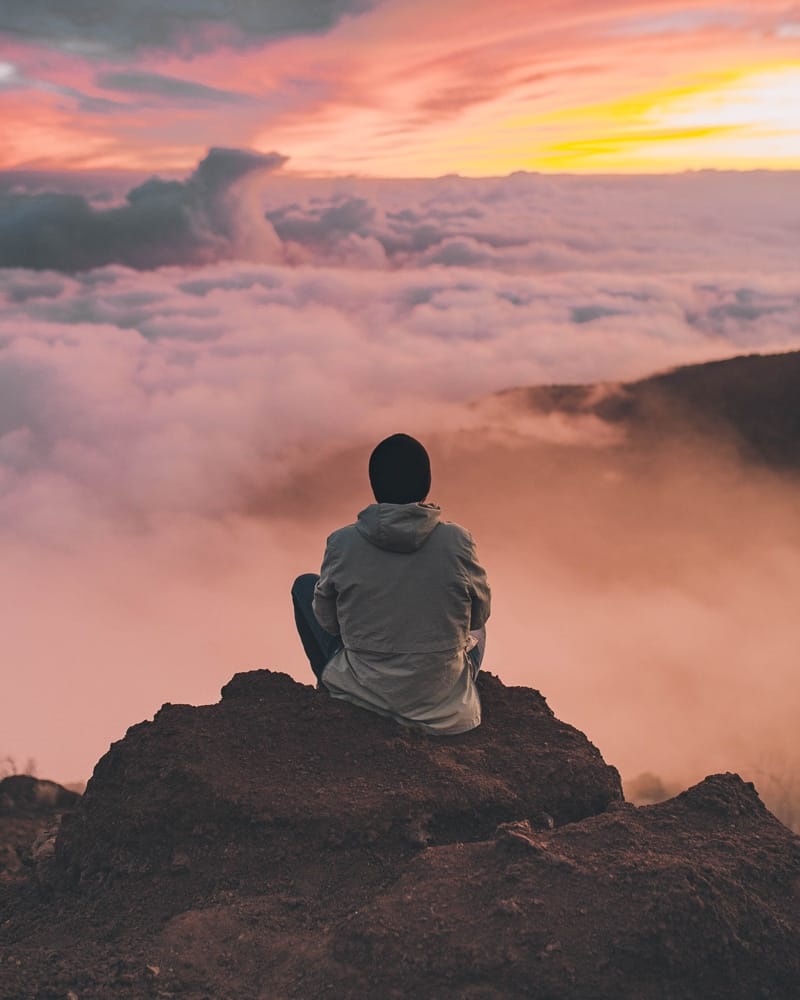

A Super Simple Travel Meditation: How to Transform Your Travel Experience
Dear reader: This article contains links to products and services that I may be compensated for, at no extra cost to you.
Meditation is an often-misunderstood word.
For many it conjures up images of cave-dwelling ascetics or posh retreats in Bali. But meditation for travelers can come in many forms, and doesn’t necessarily require isolation, silence, or sitting in a lotus pose for set period of time. It can even be as simple as staying present while traveling .
The travel meditation I’m going to introduce totally transformed the way I travel, allowing me to experience destinations and environments on a substantially deeper level, and with such profoundness that even 5, 10, 15 years later, I can still vividly recall exactly how I felt when I was in those place, forever etching those life-transforming travel experiences on my psyche.

This meditation can be done anywhere and at anytime, but there are specific locations that are more conducive than others, and travelers will generally find more opportunities to make use of this meditation due to the nature of their daily experience of visiting spiritually significant or aesthetically inspiring places on their journeys.
This meditation is incredibly simple and it is nothing new; I didn’t invent it, and it draws on an underlying component of all forms of meditation. You don’t need to join a retreat or seek guidance from an instructor, nor do you need to find quiet time and a place where no one will bother you.
Related article: Tips for Doing Yoga while Traveling
Table of Contents
Meditation for Travelers

By meditating on the places we travel to, our journey becomes a kind of pilgrimage. You don’t even have to be a religious or spiritual person to agree that as travelers, we are all pilgrims of sorts, expending great resources, energy, and time to seek out beauty and inspiration in the world.
So why not make the best of your travel experience by giving it your full attention? Go ahead and take some pictures, but at some point put your camera away and take the time to fully experience your surroundings, and here is how you can do that:
My Simple Travel Meditation
This meditation for travelers can be summarized in a single word, and this word is the underlying essence of all forms of meditation: breathing.
We are all breathing all the time, but seldom do we pay real attention to this life-sustaining act. To focus on the breath is to meditate, to dwell in the present, to be awake, to be fully alive.
In the context of travel, focusing on one’s breath while visiting a sacred, inspiring, or aesthetically beautiful environment can amplify the depth of one’s experience a hundredfold.
Colors may appear brighter, sounds more resonant, and synchronicity with ones surroundings can more easily be achieved. You can actually physically feel the connection between yourself and your environment, a state that you are always in but your mind makes you believe otherwise by convincing you that you are somehow independent of the world around you.
Different people may have different ways to practice breathing meditation, but here’s what I usually do. When I find myself in a suitable location (see below), I first correct my posture, whether I am sitting or standing (though I usually do this meditation while walking around).
Next, I initiate meditative breathing , all the while staying fully aware of my surroundings, whether it be a bustling ancient souq, mountaintop with a view, or a dark, incense smoke-filled temple. It doesn’t matter where you are, so long as you are fully aware of and connected to that place.
With every inhalation, I envision that I am inhaling all the energy present in that location. Depending on where it is, this energy can be one or both of two forms. The first is natural energy that is rooted in Mother Earth herself, and all life forms.
To focus on the breath is to dwell on the simple fact that we and the natural world are one on the same interconnected thing. The second is the energy of human presence, prayer, love, and devotion that has been left behind by other visitors.
By simply being present in a place we are simultaneously becoming a part of that place by breathing in molecules of it, and leaving behind a bit of ourselves by breathing out molecules of our bodies.
This is a scientific concept as much as a spiritual one. We do this whether we are conscious of it or not. Simply bringing awareness to the process as it is unfolding is to meditate on the interconnection of all things.

Personally I find it most effective to inhale deeply through the nose, hold the breath for several seconds in my lungs, and exhale though the mouth. As I exhale, I visualize that I am sending out peace and compassion too all forms of life sharing this place, or who will visit it in the future and share my energy and experience.
This is no different than monks who meditate on artwork such as mandalas, except that our mandala becomes the world. You could focus on the colors, the sounds, the smells, the people, the architecture, and so forth. Just like mandalas, each and every environment offers something unique.
I’ll give three personal examples from a single country that I visited, Egypt. When I went inside the Pyramid of Khafre, I meditated on the heaviness of the air, with its 4500 years of history. Atop Mount Sinai I meditated on the sunrise and the songs of a group of Christian pilgrims who were singing hymns nearby, allowing their devotion to resonate in my own body. And while scuba diving in the Red Sea, I meditated on the brilliance of the rainbow of underwater colors.
If you are traveling with a companion, it is better not to chat while meditating, and there are moments when of course you may be interrupted by people who want to communicate with you, or you may need to do something, like show a ticket, buy a drink, etc.
Do not view these as interruptions to your experience but as akin to the chattering that comes and goes in your own mind when doing classic meditation. Don’t try to avoid interruptions or get frustrated when they arise, and return to your meditation whenever circumstances become suitable again.
Unlike classic meditation, you don’t have to devote a set period of time in your day to it. Rather, you can come in and out of this state of meditation continually throughout the day whenever you see fit.

Where This Travel Meditation Works Best
As travelers we gravitate to places that are aesthetically pleasing, or culturally, historically, or religiously significant. These places also happen to be focal points of more concentrated energy, or expressed otherwise, areas where the energy that is present everywhere in the world is more readily experienced by humans.
For this reason, this meditation works best in places of immense natural beauty or of religious, cultural, or historical importance. For the former, I usually zone in on the sensual aspects, the sights, sounds, smells, and feelings of the environment while simultaneously remaining aware of my breath.
For the latter, I also try to visualize those events or ideas that made this sight sacred or significant to humans, and all those visitors who’ve journeyed there to stand in the same place. Many of the world’s holiest sights, greatest temples or monasteries, and other man-made wonders also happen to be found in locations of stunning natural beauty, and that is no coincidence, so oftentimes you can find both types of energy in one place.
Ideal places can also vary by person. If you find artwork inspiring, meditate before paintings. If you love the buzz of a noisy crowd, then try meditating on the sights and smells of a busy market. If you feel at home in the mountains, then meditate on the tress and vistas next time you are hiking rather than thinking about what you are going to do tomorrow or once you arrive at the next rest stop.
Breathing mediation is also great when eating. Close you eyes and take deep breaths while you focus your mind on the smells and flavors of the food; ponder the sources of those ingredients, the process by which they got to your table, who prepared them for you, and so on. Don’t be surprised to find that the food tastes substantially better once you simply pay proper attention to it.
Earlier in my travels I used to consciously remind myself to do breathing meditation whenever I found myself in an appropriate place, but over time I found I would automatically go into that state of breath awareness without even thinking about it every time I found myself somewhere inspiring.
Next you can take this travel meditation a step further by applying it to your daily life — to meditate on the not-so-obviously beautiful or amazing places, such as city streets, the view from your bedroom window, or even your bathroom. Because there is beauty everywhere, and we are always connected, we just need to pay attention to fully experience it.
Related Posts

2 thoughts on “A Super Simple Travel Meditation: How to Transform Your Travel Experience”
Thank you for writing this, it really resonates with me. It took awhile to adjust the mindset that leads us out of the ‘party mode’ it only serves us for so long and then it about the bigger picture of where we are instill with the moment that is now.
Leave a Comment Cancel reply

IMAGES
COMMENTS
Silent Walking Meditation: Let Murray Hidary guide you on a journey accompanied by a specially curated MindTravel music selection as you walk or hike through breathtaking locations. …
Experience deeper meditation, sleep, health, vitality, creativity & more with these meditative music experiences from composer, artist, entrepreneur, and meditation teacher Murray Hidary.
This program works in stunning urban landscapes, mountain paths, and on and beaches. Any place where music, meditation and movement come together for a magical experience. …
Find focus, clarity and flow on your commute, while traveling or while working with this MindTravel music meditation from composer and pianist Murray Hidary. At its core, MindTravel is about countering our busy lives and …
Learning to mind travel is an important stepping stone towards mastering astral travel or astral projection. Learn how to mind travel here.
MindTravel experiences take place in concert halls, museums and parks, on silent walks and hikes, on the beach in Santa Monica, on Crissy Field in San Francisco, in the Olympic pool in Culver...